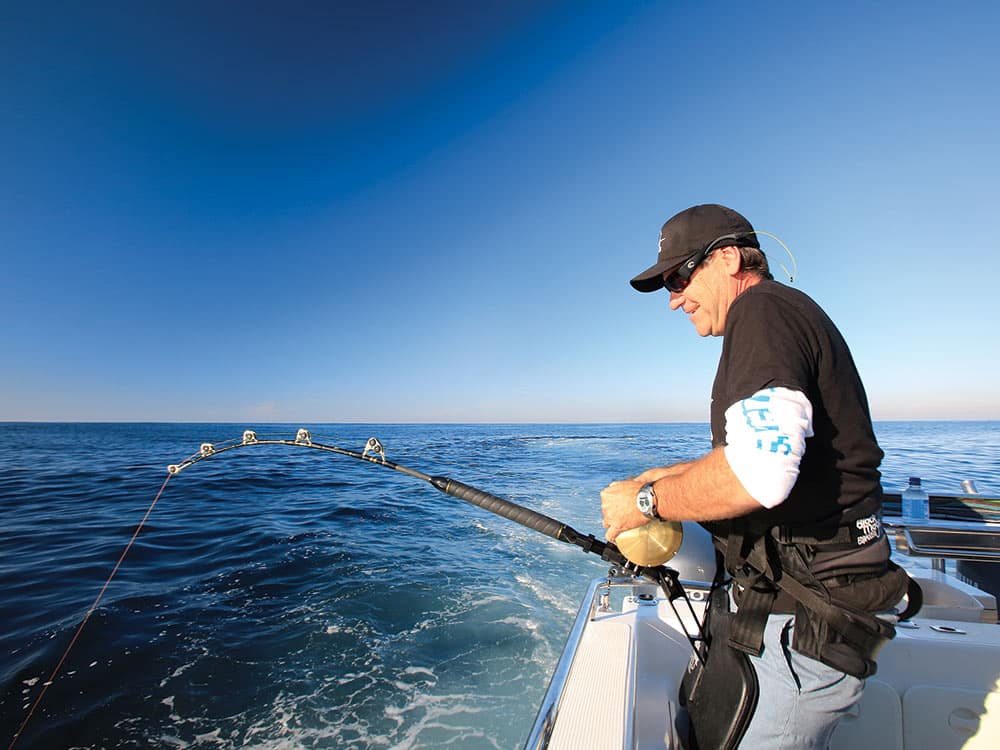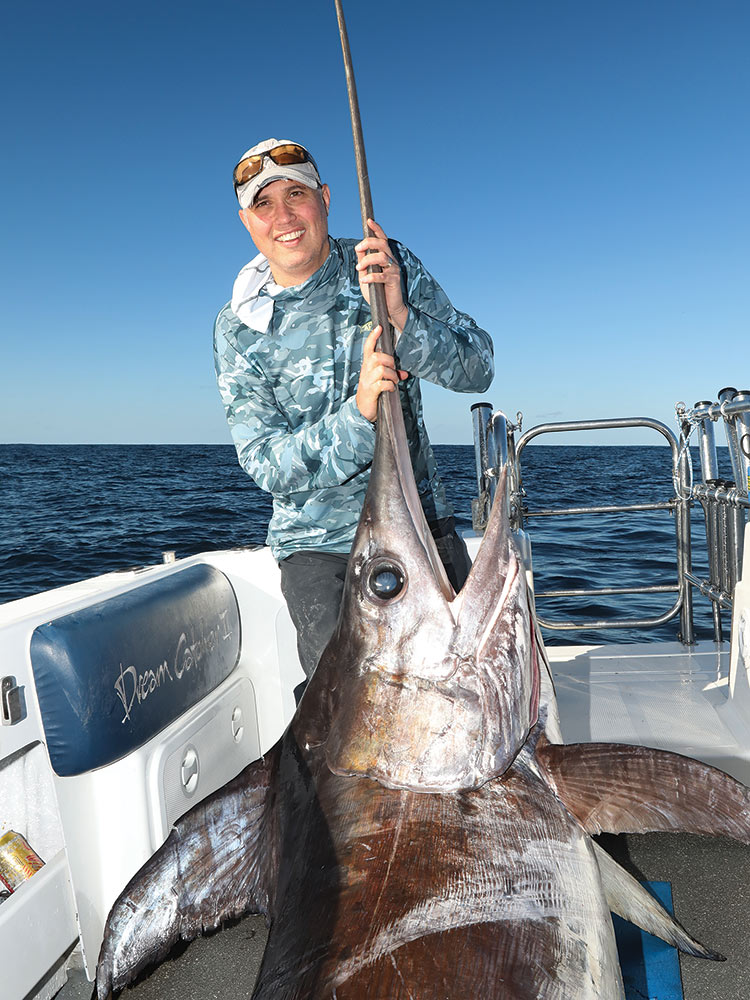
The bump on the rod tip was so subtle, it could have been easily dismissed, but everyone on board jumped to attention. Even though we had been staring at it intently for hours on end, that one little bump was exactly what we had been waiting for. It may have been slight, but it could mean only one thing: a swordfish strike.
Capt. Ritchie Abela jumped on the rod and cranked the handle of the Shimano Talica, ripping the bait up through the water column. The theory was the old cat-and-mouse analogy, trying to get the swordfish fired up. It worked a treat, and the rod tip bounced again, signaling an angry swordfish; seconds later, the rod loaded up under some serious weight. As I struggled to get the bent butt clear of the rod holder, I quickly realized that this was the fish for which we had dragged a camera crew halfway across Australia.

Unlike a blue marlin, there is nothing melodramatic about a swordfish fight. Everything is slow and steady, but they nearly always rocket to the surface after hooking up. Sure enough, that is exactly what this fish did within minutes of coming tight. I was cranking madly to keep the line tight as the fish charged up vertically from the depths. It’s amazing to think that after hooking up some 1,800 feet below, the fish was on the surface that quickly. We had the cameras ready for the jump shot, but the fish stubbornly refused and then, turning tail, it headed back down into the depths. Typical of swordfish, I expected a drawn-out, long fight, but barely an hour later, the fish came up again. This time we managed to remove the strobe lights from the line, signaling the fish was just 100 feet away.
The crew had everything set up and ready, just in case we got an early shot, and before we knew it, the fish was at the boat. Luckily, everything came together like clockwork, and with the camera crew filming everything for the Outdoor Channel’s Monster Fish, we took advantage and secured the huge swordfish.

It wasn’t until we tried to get the fish aboard that we realized just how big it really was. Abela’s Dreamcatcher 2 is a 30-foot cat so it’s not small, but the massive swordfish got stuck in the side door. Getting it on board took almost as long as the fight, taking us another hour to bring it over the transom. We realized why when it weighed in at a whopping 489 pounds.
Bright Lights, Big Fish
Daytime swordfishing really has taken off around the world, but for some reason, Australia was a bit slow on the uptake; however, once it started, this style of fishing exploded across the country. In 2014, Leo Miller and his crew decided to have a crack off Eagle Hawk Neck on Tasmania’s eastern coast. Now while the commercial guys had caught swordfish in these waters, there had never been one recorded by recreational anglers. A reasonable effort had been made at night fishing for swords, but with a huge population of makos, it proved impossible to catch anything else. So when Miller and his crew came up winners almost immediately with a 300-pound swordfish, his local counterparts called it a fluke. That did little to deter Miller, who backed it up with another quality fish. In fact, he caught three more big swordfish in the ensuing weeks. Almost instantly, his success sparked a swordfishing frenzy.

Suddenly there were anglers probing the depths right along Tasmania’s coastline, and they met with success. Unlike the Florida technique where multiple weights are added to the rig, in Tasmania, once the bait hits the bottom, the weight is snapped off. With the region’s minimal current, simply by reversing the boat the bait will stay down in the strike zone and, while it is often hard to detect the bite, once the fish is on, there is no denying it. However, what made it all the more exciting was that the average fish was huge, averaging around 250 to 300 pounds, with some real monsters cracking more than 700 pounds.
At the same time, the mainland fishery was also starting to evolve rapidly, with fish turning up everywhere from Sydney all the way to Perth in Western Australia. Despite being widespread, the biggest fish have been coming from a rather unexpected location. Naturally we expected Australia’s east coast would be central to the swordfishery since it is the main area of focus for game-fishing — especially billfish. The fact that there is a well-established longline fishery that has substantial quotas for swordfish added further weight; however, it was far eastern Victoria that proved to be the real hot spot, which is aptly named Jurassic Park.

Turning Up Everywhere
Beasts in the East
Eastern Victoria is a sparsely populated region with minimal infrastructure, which in part has helped keep it off the radar. However, the recent construction of an all-weather ocean boat ramp at Bastion Point near the remote township of Mallacoota suddenly opened the doors for a whole new fishery.
Initially, anglers targeted marlin; the first swordfish came almost as bycatch. In April 2016, Abela, Lee Rayner and Julian Coyne spent an uneventful day chasing marlin. While trolling, Abela noticed some really promising terrain showing up on the fish finder, so he decided to drop a swordfish bait. It was late afternoon, and when the bait hit the bottom, Rayner found himself instantly hooked up to 297 pounds of swordfish. This was not the first Victorian swordfish, though, because just a couple of days prior, Matt Porter had quietly caught one 100 miles west off Lakes Entrance.

The capture of these fish opened the doors on a new fishery that had been sitting undetected. Bass Canyon quickly became swordfish central, home to some true sea monsters.
Dividing Tasmania from the mainland, Bass Strait is a notoriously rugged stretch of water. It can whip up wild seas, making it impossible to access for much of the year. However, what lies beneath the surface is the hidden gem. Bass Canyon is one of the largest marine canyons in the world. Stretching more than 100 miles across and dropping to depths in excess of 11,000 feet, it is massive. A number of smaller tributary canyons drain into the greater canyon, and it’s here in the 1,300- to 1,800-foot range where it is the most productive. Loaded with amazing structure like vertical drop-offs, pinnacles, ledges and mudflats, it is home to an amazing array of life — including huge swordfish.

The best news is that it seems to be the land of giants. No small swordfish are encountered in these waters; in fact, fish under 200 pounds are rare. Better still, each season the fish seem to be getting bigger. In 2016, swordfish topped out in the 400- to 500-pound range. In 2017, things exploded, with some true giants being caught. The average size of the fish jumped up from 300 pounds to more than 400 pounds, but the biggest fish were almost doubling that again.
George Lirantzis on his Mercury-powered cat Side Effect caught an absolute monster, pulling down the scales to 764 pounds. Not bad when you consider that the day before he caught a 463-pounder, and a month before, while fishing with Abela on Dreamcatcher 2, he boated a 590‑pound beast. There have also been some monster fish released as well: Angler Chris Cleaver set free a number of fish, including a couple in the 500- to 600-pound range.

Most of the daytime deep-dropping efforts for swordfish have been focused around Everard Canyon and Western Wall. What makes it so exciting is that this is barely a drop in the ocean, with hundreds of miles of virgin country yet to be explored. How big a fish might be swimming in this canyon is anyone’s guess.
Dealing with the Weather
As exciting as this fishery is, there’s a downside, and it’s a big one. The weather is temperamental at the best of times and, when coupled with the remoteness of these grounds, it is a real issue. Winds in excess of 50 knots are not uncommon on this stretch of water, which can whip into an incredibly scary ocean. The upside is those gale-force storms are broken up by calm spells, which can see the water glass out completely. As a result, crews have to be ready to go at the drop of a hat and still might get only a single day on the water.
It’s all complicated further by the fact that the grounds are 35 to 50 miles offshore and are largely accessible only by trailer boats. This is particularly so for Mallacoota, which has no facilities for cruisers whatsoever: The only anchorage is behind Gabo Island, some 10 miles up the coast. There is no fuel or other facilities.

Lakes Entrance is the only other option. Almost 100 miles to the west, it does offer the advantage of catering to larger boats, but it also has a much longer run to the grounds. As an active port servicing the oil rigs and home to a commercial fleet, it has decent boating facilities, although be warned that there is a bar crossing that makes the port inaccessible in big seas.
Daily Bites
When it comes to seasons, we are still pretty much working it out. Last year the fishing effort didn’t start until May. Alternately, this year crews started fishing in February and were still catching them well into June. The problem is in June, the winter storms pick up tempo, making it hard to get out to sea and impossible to tell if the fish are still there.

The peak of the season so far seems to be April through June, where on good days crews get a bite on every drop. Even on slow days, it’s rare not to get at least a shot or two. As more effort is put in, we will get a clearer picture of the fishery, especially regarding the season and the effects weather and moon phases have on the fish.
Fishing techniques have also changed over the past couple of years. Initially, crews fished a single outfit, but in recent times, there has been a trend to run two rods. One rod is weighted and fished down deep near the bottom, while on the second rod, the weight snaps off so it can drift up through the water column. The free-drifting rig has worked really well in Tasmania, where there is minimal current, and it certainly produces the goods. It makes sense to cover as much of the water column as possible, and a second rod allows you to do that.

Travel Facts
Running two outfits, Abela has had a number of doubleheaders, including two doubles in a single day. He has even scored a double hookup where he managed to get both fish, an impressive effort in anyone’s book.
Daytime Is Best
Having caught a few swords at night, I can categorically say that I am happy never to do it again. Fishing at night is cold and wet, and the fishing is bloody tough. Interestingly, crews fishing overnight in the Bass Canyon have failed to get a bite but then hook up as soon as the sun rises. This is music to my ears because I am much happier to get sunburned than freeze to death.
I don’t think in Australia’s history have I seen such an excitement for a new fishery. Part of the excitement is that it’s a brand-new fishery, and we are still very much on a steep learning curve working it all out. It is only a matter of time until someone hooks the magic grander swordfish here.








